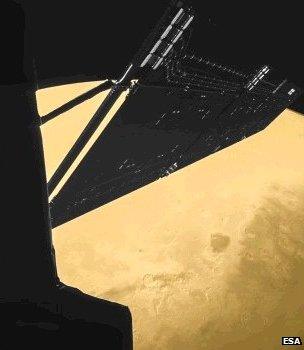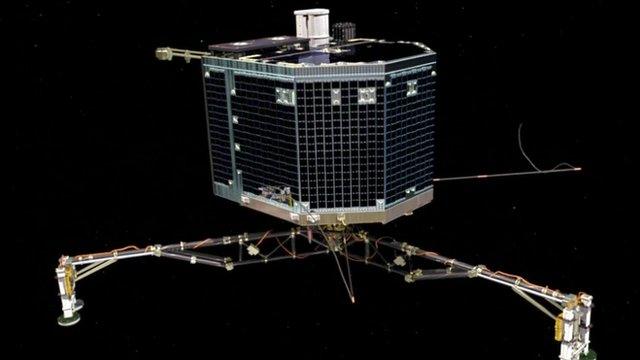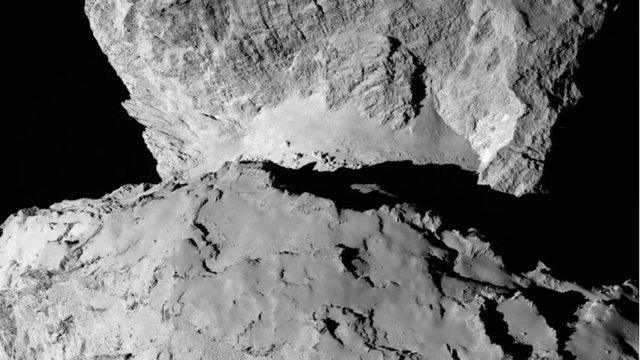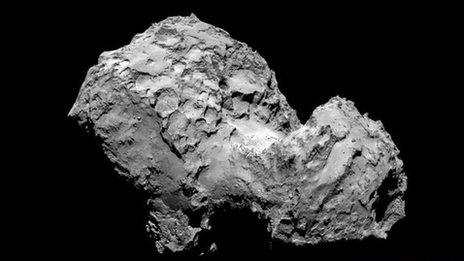Rosetta set for 'capture' manoeuvres
- Published

67P pictured by Rosetta's navigational camera system on 31 August
The Rosetta probe is about to begin the manoeuvres that will place it properly into orbit around Comet 67P/Churyumov-Gerasimenko.
The European spacecraft is currently flying arcs over the "ice mountain" that take it no closer than 52km.
But from Wednesday, Rosetta will gradually drop this distance so that come next week it will be at an altitude of just 29km.
At that point, 67P's gravity should capture the spacecraft.
European Space Agency (Esa) flight director Andrea Accomazzo said: "The first orbit - we will actually fly only half of it for seven days, and then we'll change the orbital plane and fly for another seven days.
"And then, if the comet environment allows us to continue, we'll go further down, first to 19km and then to 10km from the centre of the comet."
Scientists and engineers on the mission are busy trying to determine the best place to land on 67P.
They have put together a longlist of five sites on the 4km-wide object and need to reduce this to two - a primary and a back-up - by 15 September, when Esa expects to announce the preferences at a media conference in Paris.
The landing itself - which will be performed by Rosetta's contact robot Philae - is scheduled to take place on 11 November.
Accomazzo said mission controllers had "some headaches" in trying to work out precisely where the centre of mass is on the 10-billion-tonne, rubber-duck-shaped comet.
It is an important detail for designing a safe orbit, but the flight director expressed confidence that this issue would be resolved in the coming days.
At the moment, the comet remains quiet, with very little gas and dust streaming from its surface.
This could change at any time, however, and Accomazzo's team is ready to modify Rosetta's manoeuvres if 67P suddenly comes to life.
Meanwhile, an intense schedule of work is about to get under way to prepare Philae for its historic landing attempt.
Riding piggyback on Rosetta, the little robot has been largely a passive passenger so far.
But it will be switched on again this week to check its sub-systems for the final time.

Philae's image of Mars, taken from its attachment point on the side of Rosetta
This will involve cycling its battery and running the rule over its communications equipment.
The German space agency (DLR) team looking after Philae will also command the robot to take a picture with its own camera system.
This is something Philae has done in the past. In 2007, it famously snapped an image of Mars as Rosetta flew by the Red Planet.
This time, Philae hopes to set eyes on 67P.
"Obviously, we will not have a nice high-resolution picture as from [Rosetta's Osiris science cameras] and Navcam, but it will be interesting for us to have such a picture," said Barbara Cozzoni, a DLR operations engineer.
Rosetta scientists will be heading to Lisbon, Portugal, next week to present their early impressions of the comet to their peers.
A special session, external for the mission has been convened at the European Planetary Science Congress, external.
One issue they must settle very soon is a naming scheme for all the features on the comet's surface.
The words "Rosetta" and "Philae" recall key discoveries made in the study of ancient Egypt.
Fred Jansen, Esa's Rosetta mission manager, said the huge array of craters, cliffs, plains and boulders that populate 67P's surface could soon sport a very similar nomenclature.
"We do not have a fully agreed naming scheme yet, and we are actually late with this because there are plenty of features we can see and resolve," he told BBC News.
"I think we will go in a direction that will not surprise anybody, given Rosetta and Philae as names, and look to some sort of Egyptian theme for naming the different sites."

Jonathan.Amos-INTERNET@bbc.co.uk and follow me on Twitter: @BBCAmos, external
- Published25 August 2014

- Published7 August 2014

- Published7 August 2014
- Published21 August 2014
- Published14 August 2014

- Published6 August 2014
